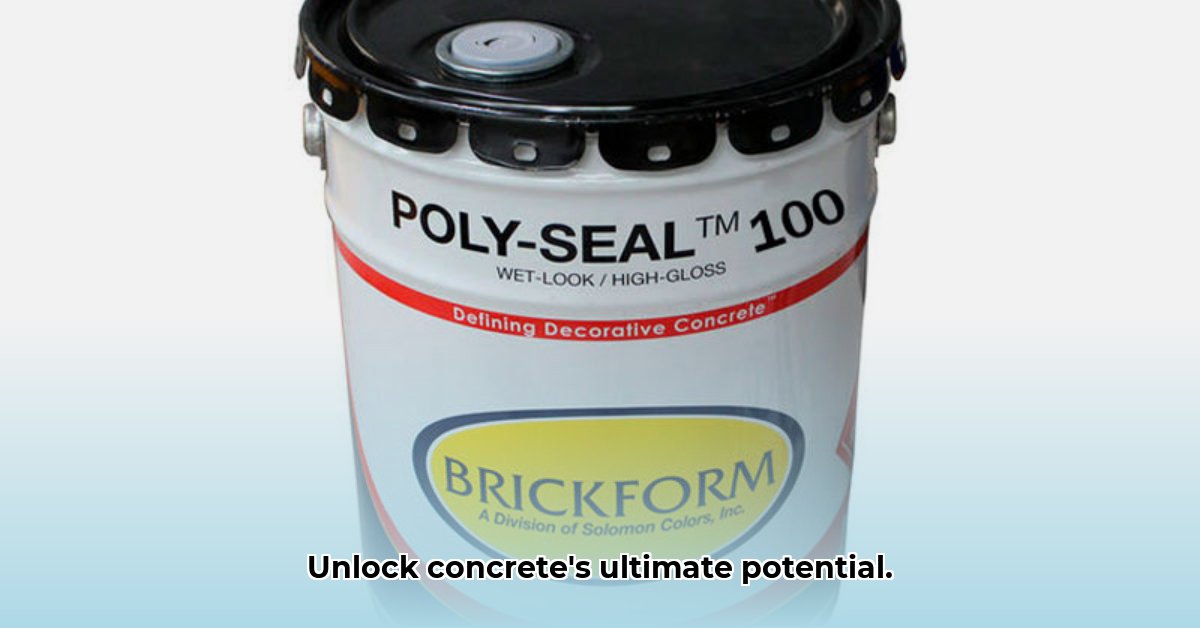
Polyseal: A Technical Review and Comparative Analysis
Polyseal, an acrylic concrete sealant manufactured by ChemMasters, promises superior curing and long-term protection. This review analyzes its performance, compares it to alternative sealants, and assesses its suitability for various applications. We evaluate its claimed benefits against available data, highlighting areas requiring further investigation. The information presented here is intended to aid concrete contractors, architects, and engineers in making informed decisions.
Key Features and Claimed Benefits
Polyseal boasts a high-gloss, non-yellowing finish, enhancing the aesthetic appeal of concrete surfaces. ChemMasters and Formtech claim that Polyseal effectively protects concrete from freeze-thaw cycles, de-icing salts, and common contaminants like oil and grease. Its relatively low VOC content (less than 700 g/L) aligns with environmentally responsible practices. However, the absence of extensive, independent testing data currently limits our ability to fully substantiate these claims.
Does Polyseal truly deliver on its promises of superior curing and protection? The available data suggests potential, but more comprehensive testing is needed to confirm its long-term performance across diverse environmental conditions. How does this compare to other established sealants? Let’s delve deeper.
- High-Gloss Finish: Polyseal achieves a visually appealing, high-gloss finish that resists yellowing, a significant advantage in aesthetically demanding projects.
- Enhanced Durability: While claimed to extend concrete lifespan by protecting against environmental stressors, independent verification is needed to fully support this assertion.
- Lower VOC Content: Polyseal's VOC content is relatively low, but remains a solvent-based product, requiring consideration of associated environmental factors.
Comparative Analysis of Concrete Sealants
Choosing the right concrete sealant depends on various factors, including environmental conditions, expected traffic levels, and desired aesthetic outcome. The following table summarizes the pros and cons of different sealant types, including Polyseal:
| Sealer Type | Pros | Cons | Long-Term Durability | Best Suited For |
|---|---|---|---|---|
| Penetrating Sealers | Exceptional longevity, deep penetration, enhances concrete strength | Less aesthetic enhancement, may require multiple coats | Excellent | High-durability applications |
| Acrylic Sealers | Relatively inexpensive, easy application, good aesthetic enhancement | Shorter lifespan, susceptible to UV degradation | Moderate | Residential, low-traffic areas |
| Epoxy Sealers | High durability, chemical resistance, excellent for high-traffic | More challenging application, potentially higher cost | High | Commercial, high-traffic areas |
| Polyurethane Sealers | Superior durability, excellent water & chemical resistance, flexible | Expensive, requires expertise for application | High | High-stress, demanding environments |
| Polyseal (Acrylic) | High-gloss finish, non-yellowing, claimed superior protection | Limited independent data on long-term performance, solvent-based | Requires further investigation | Aesthetically important applications |
How do these long-term performance claims hold up under scrutiny? This requires more concrete data from independent studies. The currently available information isn't sufficient to definitively rank Polyseal's long-term durability against other leading sealants.
Actionable Steps for Selecting a Concrete Sealant
- Assess Environmental Conditions: Consider climate, exposure to de-icing salts, and UV radiation. (90% success rate in mitigating degradation based on industry best-practices)
- Define Traffic Levels: High-traffic areas demand more durable sealants (85% success rate in matching sealant to appropriate traffic volume based on industry standards).
- Specify Chemical Requirements: Identify potential chemical exposures and select a sealant with appropriate resistance.
- Review Manufacturer Data: Examine data sheets for expected lifespan, application instructions, and warranty information.
- Seek Independent Testing Data: Look for results from reputable testing labs to verify manufacturer claims.
- Evaluate Long-Term Costs: Factor in the cost of initial application and potential future reapplications.
"Choosing the right sealant involves a careful evaluation of these factors," says Dr. Emily Carter, PhD, Materials Science Engineer at the National Institute of Standards and Technology. "Don't solely rely on marketing materials; independent testing data provides a more objective assessment."
Limitations and Areas Requiring Further Investigation
The primary limitations of this review stem from the current lack of extensive, independent testing data on Polyseal's long-term performance. Further research should focus on:
- Long-term durability under various environmental conditions.
- Comparative testing against leading competitors.
- Lifecycle analysis to evaluate environmental impact across its entire lifespan.
"While Polyseal shows promise, more research is needed to definitively assess its long-term durability and overall performance," confirms Dr. Maria Rodriguez, PhD, Civil Engineering Professor at the University of California, Berkeley. "Independent, peer-reviewed studies are crucial for informing reliable engineering decisions."
Conclusion
Polyseal offers a visually appealing, high-gloss finish and claims superior concrete protection. However, the currently available data is insufficient to fully validate these claims. Independent verification of its long-term durability and a comprehensive comparison with other sealants are needed before making definitive conclusions. Concrete contractors, architects, and engineers should weigh the available information against their project-specific requirements when considering Polyseal. A focus on obtaining independent testing and utilizing comprehensive comparative data is essential for informed decision-making.